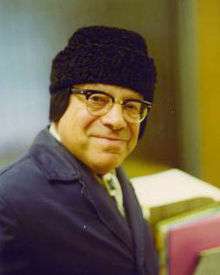Kurt Mahler

Kurt Mahler FRS[1] (26 July 1903, Krefeld, Germany – 25 February 1988, Canberra, Australia) was a mathematician.
He was a student at the universities in Frankfurt and Göttingen, graduating with a Ph.D. from Johann Wolfgang Goethe University of Frankfurt am Main in 1927; his advisor was Carl Ludwig Siegel.[2] He left Germany with the rise of Hitler and accepted an invitation by Louis Mordell to go to Manchester. However, at the start of World War II he was interned as an enemy alien in Central Camp in Douglas, Isle of Man, where he met Kurt Hirsch, although he was released after only three months.[3] He became a British citizen in 1946.
Mahler held the following positions:
- University of Groningen
- Assistant 1934-36
- University of Manchester
- Assistant Lecturer at 1937–39, 1941–44
- Lecturer, 1944–47; Senior Lecturer, 1948–49; Reader, 1949–52
- Professor of Mathematical Analysis, 1952–63
- Professor of Mathematics, Institute of Advanced Studies, Australian National University, 1963–68 and 1972–5
- Professor of Mathematics, Ohio State University, USA, 1968–72
- Professor Emeritus, Australian National University, from 1975.
He was elected a member of the Royal Society in 1948[1] and a member of the Australian Academy of Science in 1965. He was awarded the London Mathematical Society's Senior Berwick Prize in 1950, the De Morgan Medal, 1971, and the Thomas Ranken Lyle Medal, 1977.
He spoke fluent Chinese and was an expert photographer.
Mahler proved that the Prouhet–Thue–Morse constant and the Champernowne constant 0.1234567891011121314151617181920... are transcendental numbers.[4][5]
See also
- Mahler's inequality
- Mahler measure
- Mahler polynomial
- Mahler volume
- Mahler's theorem
- Mahler's compactness theorem
- Skolem–Mahler–Lech theorem
References
- 1 2 Coates, J. H.; Van Der Poorten, A. J. (1994). "Kurt Mahler. 26 July 1903-26 February 1988". Biographical Memoirs of Fellows of the Royal Society. 39: 264. doi:10.1098/rsbm.1994.0016.
- ↑ Kurt Mahler at the Mathematics Genealogy Project
- ↑ Biography of Kurt Mahler available from www.educ.fc.ul.pt
- ↑ Kurt Mahler, "Arithmetische Eigenschaften der Lösungen einer Klasse von Funktionalgleichungen", Math. Annalen, t. 101 (1929), p. 342–366.
- ↑ Kurt Mahler, "Arithmetische Eigenschaften einer Klasse von Dezimalbrüchen", Proc. Konin. Neder. Akad. Wet. Ser. A. 40 (1937), p. 421–428.